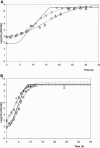Effects of preculturing conditions on lag time and specific growth rate of Enterobacter sakazakii in reconstituted powdered infant formula
- PMID: 16597976
- PMCID: PMC1448981
- DOI: 10.1128/AEM.72.4.2721-2729.2006
Effects of preculturing conditions on lag time and specific growth rate of Enterobacter sakazakii in reconstituted powdered infant formula
Abstract
Enterobacter sakazakii can be present, although in low levels, in dry powdered infant formulae, and it has been linked to cases of meningitis in neonates, especially those born prematurely. In order to prevent illness, product contamination at manufacture and during preparation, as well as growth after reconstitution, must be minimized by appropriate control measures. In this publication, several determinants of the growth of E. sakazakii in reconstituted infant formula are reported. The following key growth parameters were determined: lag time, specific growth rate, and maximum population density. Cells were harvested at different phases of growth and spiked into powdered infant formula. After reconstitution in sterile water, E. sakazakii was able to grow at temperatures between 8 and 47 degrees C. The estimated optimal growth temperature was 39.4 degrees C, whereas the optimal specific growth rate was 2.31 h(-1). The effect of temperature on the specific growth rate was described with two secondary growth models. The resulting minimum and maximum temperatures estimated with the secondary Rosso equation were 3.6 degrees C and 47.6 degrees C, respectively. The estimated lag time varied from 83.3 +/- 18.7 h at 10 degrees C to 1.73 +/- 0.43 h at 37 degrees C and could be described with the hyperbolic model and reciprocal square root relation. Cells harvested at different phases of growth did not exhibit significant differences in either specific growth rate or lag time. Strains did not have different lag times, and lag times were short given that the cells had spent several (3 to 10) days in dry powdered infant formula. The growth rates and lag times at various temperatures obtained in this study may help in calculations of the period for which reconstituted infant formula can be stored at a specific temperature without detrimental impact on health.
Figures






Similar articles
-
Growth kinetics and model comparison of Cronobacter sakazakii in reconstituted powdered infant formula.J Food Sci. 2012 Sep;77(9):E247-55. doi: 10.1111/j.1750-3841.2012.02873.x. Epub 2012 Aug 17. J Food Sci. 2012. PMID: 22900603
-
Growth of Enterobacter sakazakii in reconstituted infant formula as affected by composition and temperature.J Food Prot. 2007 Sep;70(9):2095-103. doi: 10.4315/0362-028x-70.9.2095. J Food Prot. 2007. PMID: 17900088
-
Survival of Enterobacter sakazakii in powdered infant formula as affected by composition, water activity, and temperature.J Food Prot. 2007 Jul;70(7):1579-86. doi: 10.4315/0362-028x-70.7.1579. J Food Prot. 2007. PMID: 17685328
-
Enterobacter sakazakii and other bacteria in powdered infant milk formula.Matern Child Nutr. 2005 Jan;1(1):44-50. doi: 10.1111/j.1740-8709.2004.00008.x. Matern Child Nutr. 2005. PMID: 16881878 Free PMC article. Review.
-
Cronobacter spp. in powdered infant formula.J Food Prot. 2012 Mar;75(3):607-20. doi: 10.4315/0362-028X.JFP-11-285. J Food Prot. 2012. PMID: 22410240 Review.
Cited by
-
Comparison of two optical-density-based methods and a plate count method for estimation of growth parameters of Bacillus cereus.Appl Environ Microbiol. 2010 Mar;76(5):1399-405. doi: 10.1128/AEM.02336-09. Epub 2010 Jan 15. Appl Environ Microbiol. 2010. PMID: 20081006 Free PMC article.
-
Investigation on the Factors Affecting Cronobacter sakazakii Contamination Levels in Reconstituted Powdered Infant Formula.Front Pediatr. 2015 Aug 24;3:72. doi: 10.3389/fped.2015.00072. eCollection 2015. Front Pediatr. 2015. PMID: 26380247 Free PMC article.
-
Development of a novel screening method for the isolation of "Cronobacter" spp. (Enterobacter sakazakii).Appl Environ Microbiol. 2008 Apr;74(8):2550-3. doi: 10.1128/AEM.02801-07. Epub 2008 Feb 29. Appl Environ Microbiol. 2008. PMID: 18310415 Free PMC article.
-
Comparative analysis of the human saliva microbiome from different climate zones: Alaska, Germany, and Africa.BMC Microbiol. 2014 Dec 17;14:316. doi: 10.1186/s12866-014-0316-1. BMC Microbiol. 2014. PMID: 25515234 Free PMC article.
-
Development and application of a novel peptide nucleic acid probe for the specific detection of Cronobacter genomospecies (Enterobacter sakazakii) in powdered infant formula.Appl Environ Microbiol. 2009 May;75(9):2925-30. doi: 10.1128/AEM.02470-08. Epub 2009 Mar 6. Appl Environ Microbiol. 2009. PMID: 19270117 Free PMC article.
References
-
- Baranyi, J., and T. A. Roberts. 1995. Mathematics of predictive food microbiology. Int. J. Food Microbiol. 26:199-218. - PubMed
-
- Begot, C., I. Desnier, J. D. Daudin, J. C. Labadie, and A. Lebert. 1996. Recommendations for calculating growth parameters by optical density measurements. J. Microbiol. Methods 25:225-232.
-
- Farmer, J. J., III, M. A. Asbury, F. W. Hickman, D. J. Brenner, and the Enterobacteriaceae study group. 1980. Enterobacter sakazakii: a new species of “Enterobacteriaceae” isolated from clinical specimens. Int. J. Syst. Bacteriol. 30:569-584.
-
- Heuvelink, A. E., M. Ahmed, F. D. Kodde, J. T. M. Zwartkruis-Nahuis, and E. de Boer. 2002. Enterobacter sakazakii in melkpoeder. De Ware (n) Chemicus 32:17-30.
-
- Iversen, C., M. Lane, and S. J. Forsythe. 2004. The growth profile, thermotolerance and biofilm formation of Enterobacter sakazakii grown in infant formula milk. Lett. Appl. Microbiol. 38:378-382. - PubMed
Publication types
MeSH terms
Substances
LinkOut - more resources
Full Text Sources
Medical
Molecular Biology Databases

